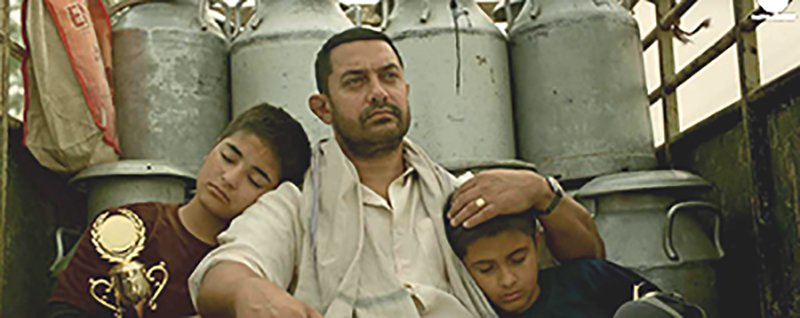Dangal: Damning Indictment of State Administration of Sports

I watched Aamir Khan’s Dangal on You Tube last evening, courtesy a camera print uploaded by a Good Samaritan who saved me the tortuous journey and back to and from a South Delhi cineplex. I also saved over a thousand bucks in the process – a King’s ransom in today’s cashless world.
Dangal is perhaps Bollywood’s severest indictment of sports administration in India, a continuum in Aamir Khan’s series of socially-themed movies. I write this review although I seldom watch a Hindi movie.
Notwithstanding an elaborate nationwide network of state-owned training facilities, India’s achievements admitted by IOA are a gold medal each at the Olympics in 1928, 1932, 1936, 1948, 1952, 1956, 1964, 1980, two silver medals in 1900, 1960, 2004 and two in 2012, and a bronze each in 1952, 1968, 1972, 1996, 2000, 2008 and four in 2012, i.e. a total of 8 gold, 6 silver and 10 bronze – 24 medals in a span of 115 years, an average of an Olympic medal every five years for a sixth of the world’s population!
India’s performance in successive Commonwealth Games from 1970-2014 (except 1986 for which data is not available) netted it 422 medals of 6848 that were available. Of those India won, 151 were gold (7%), 148 silver (7%) and 123 bronze (5%), effectively making for an average tally of a minuscule 6.5% of all medals awarded. This is when India is the Commonwealth’s most populous and second largest (by area) member.
For state-hired coaches are mainly beneficiaries of the vast network of bureaucratic and political patronage, the best thing to do was to have locked away the father (Aamir Khan) in a room while his daughter went on to achieve her landmark international laurel.
The NIS coach evidently possessed bookish knowledge and, by his physical stature, was a caricature of a wrestler without any real world sportive wrestling, much like the patrons of all our national and state sports associations. When the coach finds the father’s (Aamir Khan) home-grown ‘dehati’ training and advice more relevant that his, he seeks cover of a committee that rules that the father cannot enter NIS, nor can his daughter, Geeta, meet him but that Geeta and her sister, Babita, get another chance to ‘redeem’ themselves.
The sound of the national anthem playing while the father, who is deliberately locked up at the coach’s instance to prevent him from advising his daughter during her career-critical international performance, is the severest indictment of a sports administration that has little competence, save for canvassing for employment as coaches.
The arrogant, intemperate and colic-stricken coach who asks the father to ‘get out’ of the training facility is in stark contrast to the personal commitment of excellence of a father to his daughter and to wrestling and adds to the severe indictment of what ails sports in India today. The father is content clapping for his daughter from the stands but the coach more concerned with ‘buck-up’ messages in inter-round breaks and horsing around for the media.
What is equally interesting is the earthy touch to the movie, be it by rural location, popular gender prejudices, costumes and its down-to-earth realistic complexion, complete with Sakshi Tanwar as the fearful wife.
Even more interesting is the home grown facilities for training wrestlers that combines ingenuity with knowledge handed down over generations. That a single defeat for Geeta in the 55 kg. class was sufficient for the NIS coach to order his dietician to regulate her meals so that she came down to the 51 kg. class pitted against the conviction of her father that she must compete in the 55 kg. class only spoke volumes of the bookish knowledge and bureaucratic caution of the NIS coach.
A father-enforced protein diet versus a coach-ordained veggie diet spoke of generational experience. Such common sense was not evident in the coach’s handling. Even long versus short-hair, fashion against sporting functionality, father versus coach, speaks of unpaid but loyal commitment pitted against superfluous but state-paid self-defeating appearances.
The Haryanvi dialect lends the authenticity while the real-life rural surroundings impart the requisite degree of realism to Aamir Khan’s laudable venture. The actresses, particularly both junior and senior Geetas, did with their natural beauty that over make up could not have achieved. Best of all was that viewers were spared the insult to their sensibilities in not having to see ageing and illusorily curvaceous beauties masquerading as sportspersons.
Aamir Khan also makes a welcome statement about gender equality, indeed superiority of the feminine, in a traditionally masculine sport. The capture on celluloid of life in a rural hamlet did not reek of too much set shooting either. A fair amount of research also went into the creation of rural training facilities, without any state support. To the contrary, state support manifested in huge infrastructure NIS comes out mostly as a colossal waste of public moneys.
The father being led away by a person saying the President of the Wrestling Federation of India (WFI) wanted to meet him, before being securely locked away in a changing room, makes a case for disbanding the WFI without any further delay and stopping all grants-in-aid from government to it.
Although I moved away from my desktop screen after the movie with a sense of tremendous satisfaction, yet I could not resist noting that the movie was about a half hour longer than what was warranted.
My compliments to Aamir Khan are certainly due for his severe indictment of the ineffectiveness of state sponsorship of sports in India as also for his series of movies that have most effectively themed pressing problems from autism and education to sports and much more.
However, I must equally admit that Aamir Khan looks better in his juvenile impish physical avatar than as a pound-stricken senior citizen.
(The writer is a senior public policy analyst and commentator)



